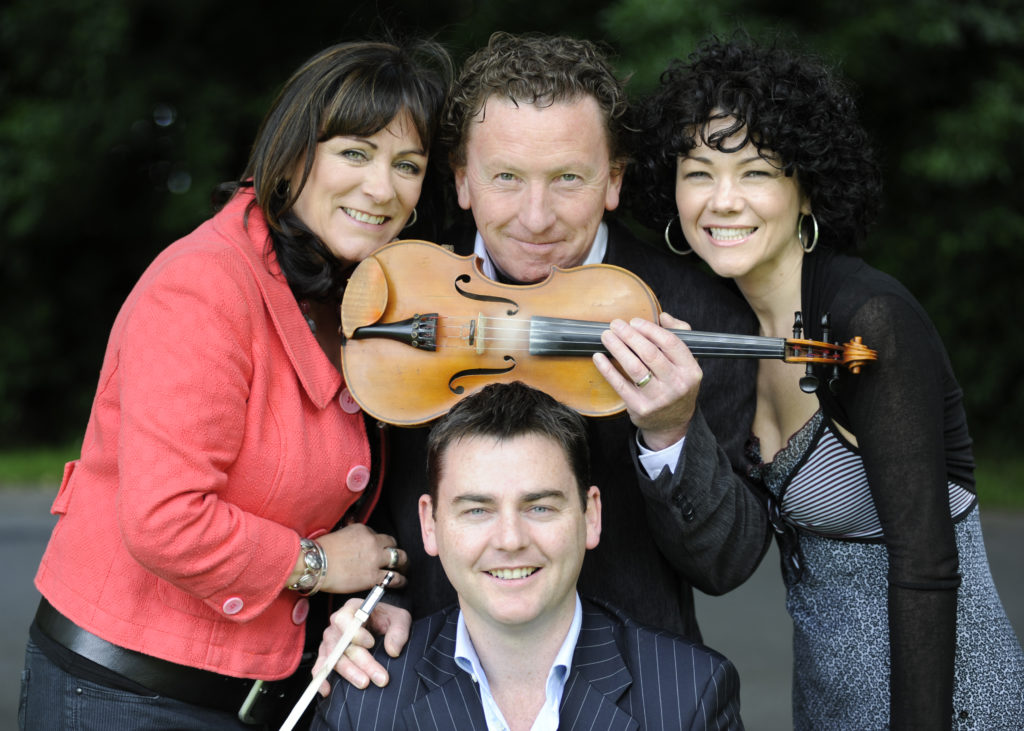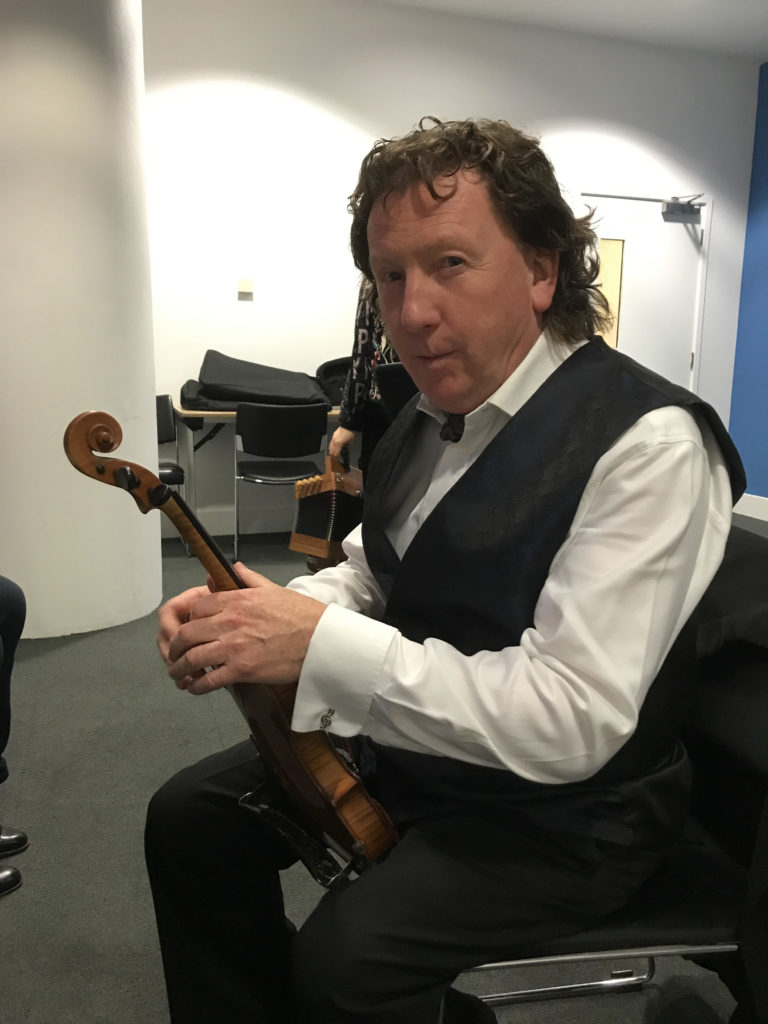Stage three cancer, lost friends, legal rows, but Frankie Gavin is still standing, still fiddling, still Frankie
 Mary Black, Frankie Gavin, Michelle Lally and Eric Cunningham (picture Sasko Lazarov:RollingNews.ie)
Mary Black, Frankie Gavin, Michelle Lally and Eric Cunningham (picture Sasko Lazarov:RollingNews.ie)HAVING played for four American Presidents, somehow it seemed appropriate and amusing to be meeting up with my old friend, the virtuoso fiddler Frankie Gavin, at The President Hotel in Bloomsbury. When he was just six years old, Frankie had played for President John F. Kennedy, but was later invited by George W. Bush, followed by Bill Clinton and Obama.
Frankie was in London with the latest iteration of his group De Dannan to headline one of the “Return to London” concerts promoted by Irish Music and Dance London at the Bloomsbury Theatre.
In recent years I have had a cardinal rule that, when meeting people of my own generation, I never, under any circumstances, risk asking them how they are — as inevitably they will answer with lurid descriptions of recent medical procedures. However, here, before talking about music, I broke the rule immediately, as I was most concerned to find out if Frankie had recovered from his recent cancer scare. Mercifully, he told me he was fine — but had been very lucky.
“I had stage three oesophageal cancer,” Frankie said. “And a friend of mine who's a doctor — he's actually a gastroenterologist in Dublin — he got me checked out, basically because it was just after Covid and it was impossible to get appointments. It was very difficult. But he got me an appointment in Dublin, as I was burping and then not being able to swallow food — it would just get stuck there and I couldn't swallow. So I was fading away with hunger and it was just awfully upsetting.
“It so happened that my daughter Ruby saw an article in The New York Times. She was in New York at the time and she saw this article about a game-changer in oesophageal cancer by two Irish doctors — Dr Greg Leonard, and another doctor who lives in America.
“Where does he live, this Greg Leonard? Only Galway! Praise be to God. So I was on to him and he took on my case. When I met him, he looked, like, very serious.
“I mean, it was stage three. You know what I mean? I mean stage anything is bad — but stage three? You're a goner anyway. So it was just got in time. But anyway, he said, this is what we're gonna do: we're gonna have this, we're gonna do that, we’re gonna have radiotherapy. We're gonna have to get all the chemo and all this kind of stuff that nearly killed me anyway, you know.
“And I mean, they eventually had the tubes into me just to feed me, like. You know, he got me through all that, and I had an absolute resurgence of health — and hair growth.
“The next thing was he contacted me and said, ‘I'd like to see you in the office.’ I thought: this is serious. This means really bad news.
“He said, ‘Have a look there.’
“I said, ‘I can’t see anything.’
“He said, ‘That’s the point. There’s nothing. It’s completely clear.’ It was like an absolute miracle.
The powers of modern science and all the rest of it — also known as the grace of God.”
I was obviously delighted to hear this news, and certainly Frankie did seem to have his old mischievous sparkle back. I noted that (characteristically for Frankie) he complained on the way to the venue that he had paid for dinner — because, as we ate at his hotel, it just went on to his room bill.
Our friendship/business relationship all started such a long time ago — back in about 1976. The original De Dannan, formed in Spiddal near Galway after enjoying sessions in Hughes’s pub, consisted of Frankie, Alec Finn, Ringo McDonagh and Charlie Piggot. Dolores Keane joined them on their first album — which was produced by Dónal Lunny for Polydor. This was released in early 1976 but unfortunately, soon after the release, Dolores left the band.
Frankie took up the story: “John Faulkner came to Ireland with the BBC crew to make a documentary about Irish music and the next thing was, John and Dolores teamed up.
“Dolores announced: ‘I'm leaving the band. I’m going to live with John in Palmers Green in London.’
“The news — ah, it was a terrible moment. My heart sank when she left. It was sad, a really sad day, but we had to carry on. So after Dolores, we had Andy Irvine briefly, and we did the tour of Germany with Andy. There was a conflict with Andy’s own dates so he left and Johnny Moynihan came in — and perhaps that was when we asked you to come in and help with management and to organise a UK tour and get us a new record deal.”
I THINK Andy or Johnny had mentioned my name to Alec, as a year before, in 1975, I had organised the Planxty UK tour, which they were on. So Alec called me, and I remember the first time I saw the band was at the Project Arts Theatre in Dublin, at the back of the Clarence Hotel.
I recalled to Frankie: “From then I spent loads of time with you in Galway. I would stay, along with my family, at Oranmore Castle with Alec and Leonie, and we all became good friends, doing several projects over the years.”
The first of these projects was Frankie’s next album Selected Jigs and Reels, which we eventually signed to Decca. I had become Head of Promotion for the label. I brought Roger Perry over to do great pictures in the castle, which went on the posters and album cover.
From then on, there were myriad albums and a few tours and festivals.
Maura O’Connell joined the group and recorded the Song for Ireland album in Windmill Lane Studio, but then — before release — Maura left.
That was when a young Mary Black…
I reminded Frankie that we’d brought Mary to London and, in Livingston Studios in Wood Green, we took Maura’s voice off the multi-tracks and recorded Mary. I still think her version of Song for Ireland is the absolute best, and it was great to film you all performing it in a ‘summer sunset’ for the Windmill Lane Co-Production TV programme. I still have the large 2-inch master tapes.
Around that time, I was coordinating the music for the big TV drama series for Channel Four and PBS in America, The Irish RM, with Peter Bowles, Beryl Reid and Bryan Murray, so I brought De Dannan over to Olympic Studios in Barnes to record all the ethnic Irish music elements for the 18-week series.
“That was a lot of fun,” I said to Frankie. “Although not without De Dannan dramas.” The band were no strangers to drama and legal disputes, including a long, much-publicised spat when Frankie and founder member Alec fell out publicly and did not speak for several years. Fortunately, these two old friends and creative collaborators made their peace before Alec Finn sadly died in November 2018.
Previously I had half-jokingly suggested to Frankie that he could be considered the Irish version of John Mayall — as over all these years, so many new young Irish musicians had been given an early break with one of the many De Dannan line-ups and had then gone on to forge their own highly successful careers. And I wondered how he found these new, exceptionally talented musicians.
“Well, some come to me,” he said, “but then somebody would tip me off and say, listen, check out so-and-so. I mean, wait until you hear this team that are playing with me this evening… I'm back playing music happier than I ever was before, and healthier than I ever was before — happier being the most important detail.”
I was soon to discover that this new line-up of the legendary group De Dannan is as creative and inspiring as any from the band’s long history and, apart from featuring the inimitable Frankie Gavin on fiddle and flute, it included Diarmuid Ó Meachair (melodeon/button accordion), Ian Kinsella (guitar), Kaitlin Cullen-Verhauz (vocals/cello), and Jack Talty (keys).
For sure, they did not disappoint me — or the enthusiastic, knowledgeable audience. An added bonus was to hear the beautiful voice of Kaitlin, who gave us moving renditions of a Percy French song as well as an emotional interpretation of Follow Me Up to Carlow — a song usually sung by men.
Once again, Frankie has a great new incarnation of De Dannan and, happily — by the grace of God — we have the reincarnation of the everlasting Frankie Gavin and De Dannan.
 Frankie tuning up (photo Mick McDonagh)
Frankie tuning up (photo Mick McDonagh)De Dannan: the shape-shifters of Irish traditional
IN THE grand constellation of Irish traditional music, a coterie of bands come to mind: the Clancys, the Dubliners, the Chieftains, Planxty, the Bothy Band. Each forged a path that left the tradition both richer and more expansive than they found it.
Among them, De Dannan occupies a curious but critical place — a band of brilliant contradictions, shape-shifters who somehow managed to be both radical and rooted, mischievous and masterful.
De Dannan emerged just as the Irish folk revival of the 1960s and early 1970s was entering a more experimental phase. With Frankie Gavin’s dazzling fiddle at the centre — dexterous, daring — the band quickly carved a distinct sound. Alec Finn’s bouzouki, Charlie Piggot’s banjo, and Ringo McDonagh’s bodhrán created a rhythmic and harmonic bedrock that allowed experimentation to take place on its foundations.
If the Dubliners popularised Irish music for the pub and the parlour, and the Chieftains brought it to the concert hall, De Dannan brought it to the cabaret and, occasionally, the circus. They recorded reels at breakneck speeds, borrowed freely from classical and pop, and weren’t above throwing in a Beatles cover or a Strauss waltz mid-set. Their 1980s version of Hey Jude on fiddle and harpsichord became a talking point — and a dividing line. Purists scoffed, but others hailed them as genre-benders long before the word existed.
Arguably, De Dannan were not as seminal as the Bothy Band in terms of redefining the template of the Irish trad group, nor as foundational as Planxty in blending song and instrumental sophistication. But they were, arguably, more accessible — a gateway for casual listeners who might have found the intensity of the Bothy Band overwhelming or the solemnity of the Chieftains too reverent.
What makes De Dannan vital is their role as incubators of talent. Their ever-changing line-up — which has included Maura O’Connell, Dolores Keane, Mary Black, Eleanor Shanley, Johnny Moynihan and others — reads like a roll call of Irish folk royalty. If Planxty was a meeting of minds, and the Bothy Band a supergroup, De Dannan was a finishing school.
Frankie Gavin's continuing reinventions of the band — with young musicians alongside him on stage now — underline their enduring legacy. De Dannan may never have had the gravitas of the Chieftains or the mythic status of Planxty, but their contribution to Irish music is no less profound. They were — and still are — proof that tradition doesn’t just survive change. It thrives on it.

